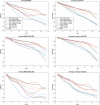Deterministic skill of ENSO predictions from the North American Multimodel Ensemble
- PMID: 31929685
- PMCID: PMC6936341
- DOI: 10.1007/s00382-017-3603-3
Deterministic skill of ENSO predictions from the North American Multimodel Ensemble
Abstract
Hindcasts and real-time predictions of the east-central tropical Pacific sea surface temperature (SST) from the North American Multimodel Ensemble (NMME) system are verified for 1982-2015. Skill is examined using two deterministic verification measures: mean squared error skill score (MSESS) and anomaly correlation. Verification of eight individual models shows somewhat differing skills among them, with some models consistently producing more successful predictions than others. The skill levels of MME predictions are approximately the same as the two best performing individual models, and sometimes exceed both of them. A decomposition of the MSESS indicates the presence of calibration errors in some of the models. In particular, the amplitudes of some model predictions are too high when predictability is limited by the northern spring ENSO predictability barrier and/or when the interannual variability of the SST is near its seasonal minimum. The skill of the NMME system is compared to that of the MME from the IRI/CPC ENSO prediction plume, both for a comparable hindcast period and also for a set of real-time predictions spanning 2002-2011. Comparisons are made both between the MME predictions of each model group, and between the average of the skills of the respective individual models in each group. Acknowledging a hindcast versus real-time inconcsistency in the 2002-2012 skill comparison, the skill of the NMME is slightly higher than that of the prediction plume models in all cases. This result reflects well on the NMME system, with its large total ensemble size and opportunity for possible complementary contributions to skill.
© The Author(s) 2017.
Figures












References
-
- Barnston AG, Tippett MK. Predictions of Nino3.4 SST in CFSv1 and CFSv2: a diagnostic comparison. Clim Dyn. 2013;41:1–19. doi: 10.1007/s00382-013-1845-2. - DOI
-
- Barnston AG, van den Dool HM, Zebiak SE, Barnett TP, Ji M, Rodenhuis DR, Cane MA, Leetmaa A, Graham NE, Ropelewski CF, Kously VE, O’Lenic EA, Livezey RE. Long-lead seasonal forecasts—where do we stand? Bull Am Meteor Soc. 1994;75:2097–2114. doi: 10.1175/1520-0477(1994)075<2097:LLSFDW>2.0.CO;2. - DOI
-
- Barnston AG, Chelliah M, Goldenberg SB. Documentation of a highly ENSO-related SST region in the equatorial Pacific. Atmosphere-Ocean. 1997;35:367–383. doi: 10.1080/07055900.1997.9649597. - DOI
-
- Barnston AG, Tippett MK, L’Heureux ML, Li S, DeWitt DG. Skill of real-time seasonal ENSO model predictions during 2002–2011. Is our capability increasing? Bull Am Meteor Soc. 2012;93:631–651. doi: 10.1175/BAMS-D-11-00111.1. - DOI
LinkOut - more resources
Full Text Sources
Miscellaneous
